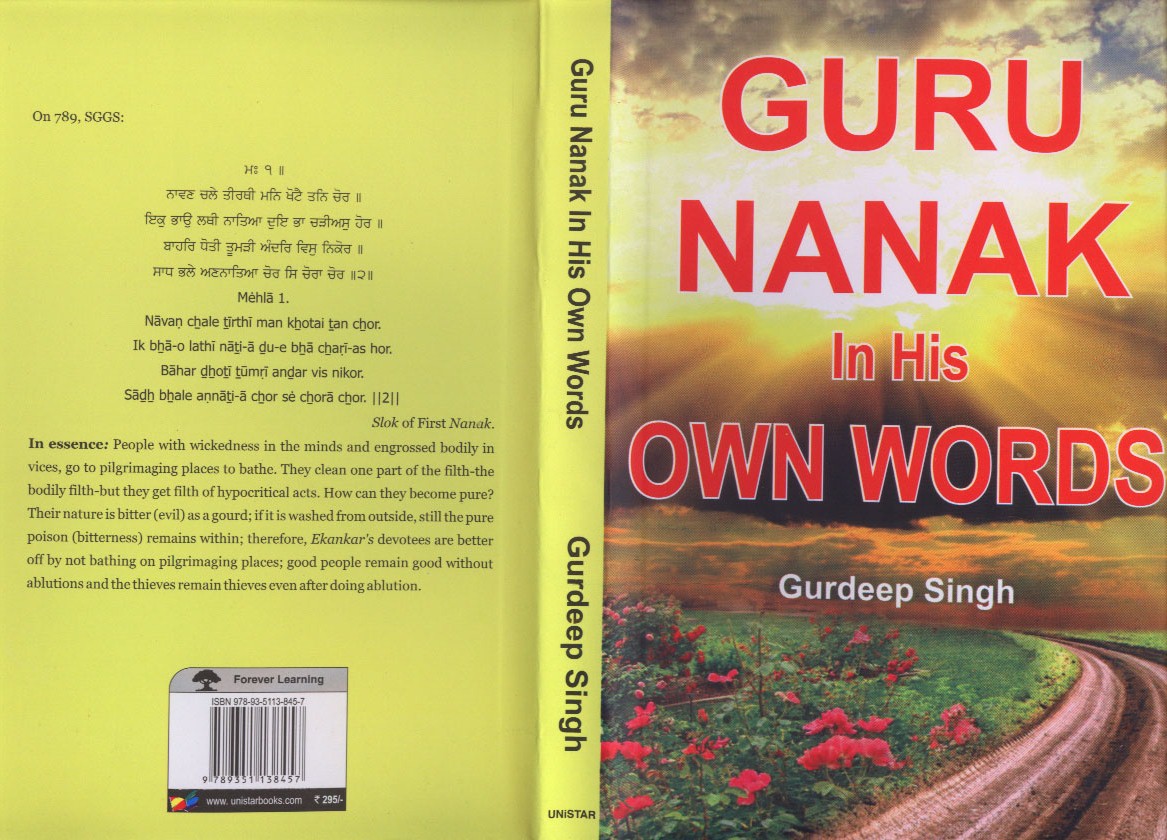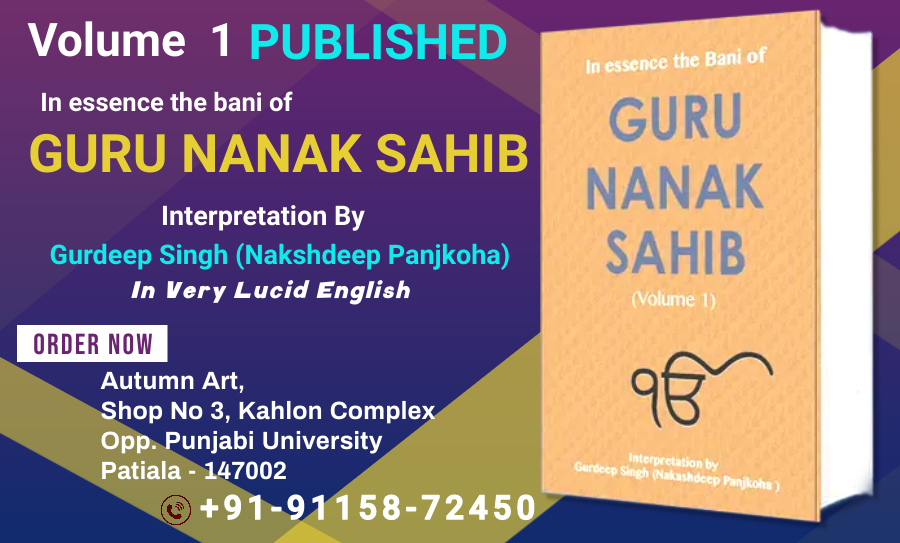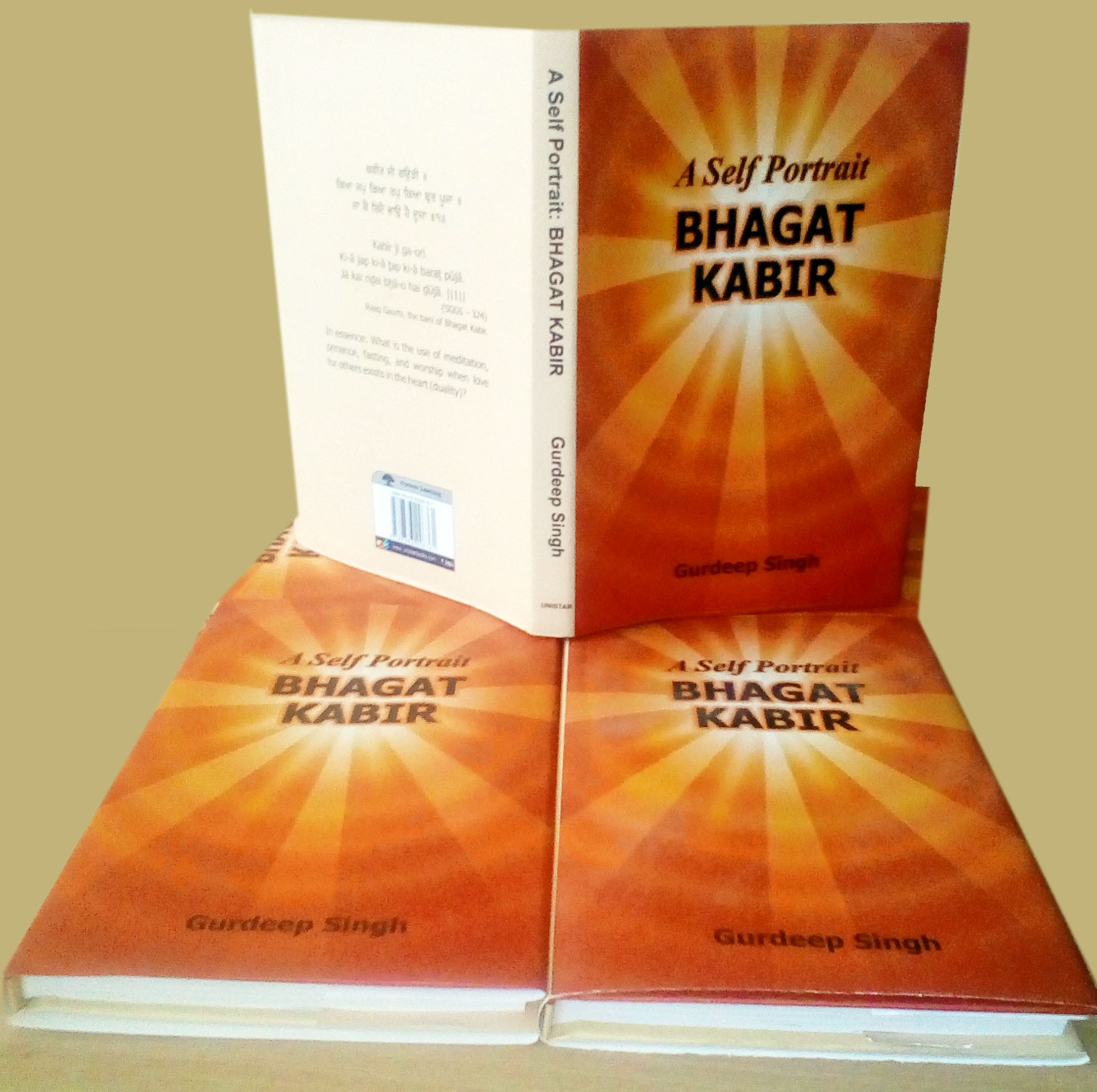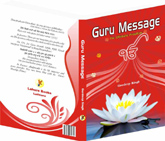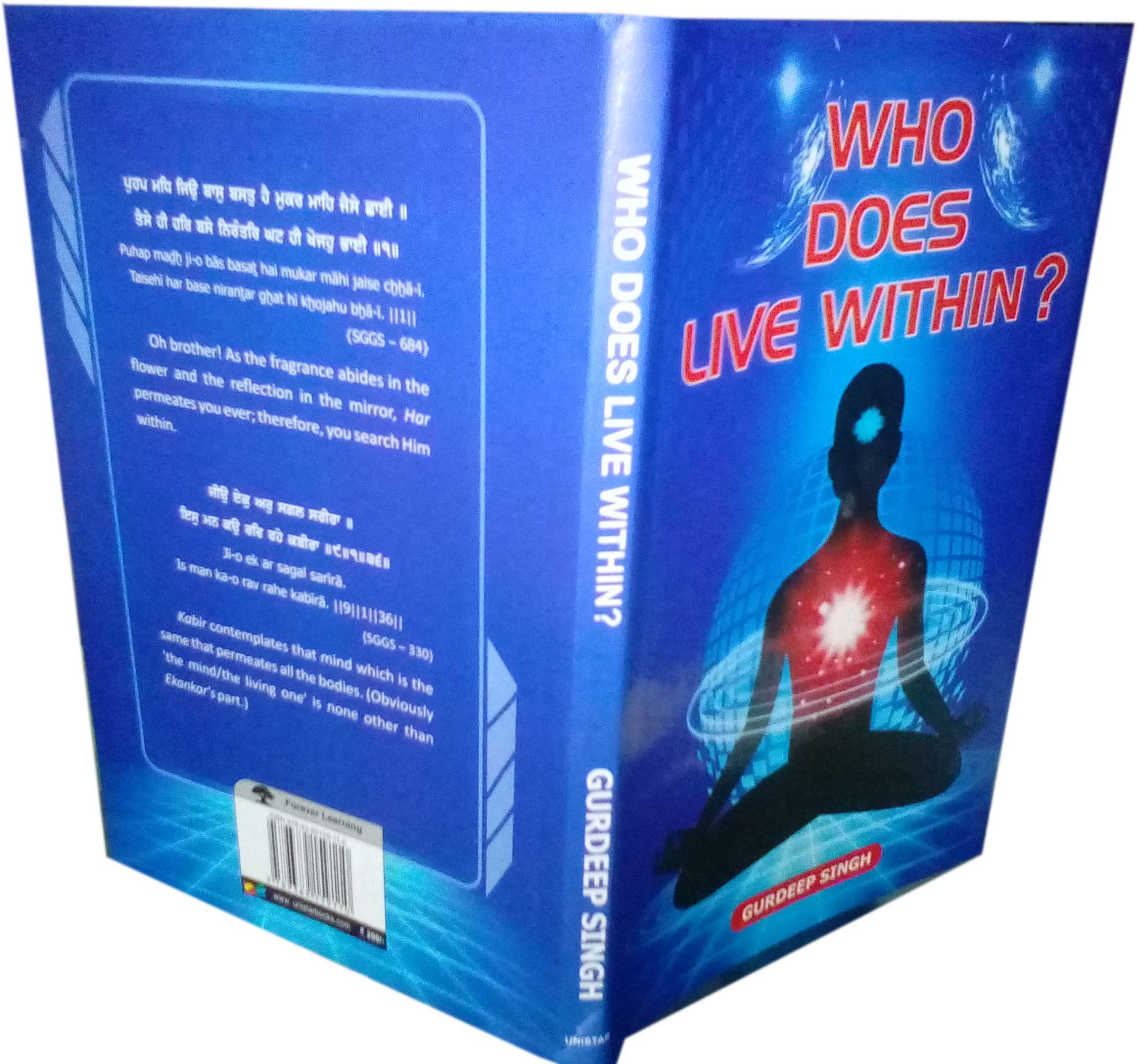We don’t know why and when the bani “Sukhmani” was written, and believing in stories about it doesn’t help us anyway. In Santhya Bhai Veer Singh relates some stories given in “Suraj Parkash”. According to that, some followers asked the Guru to write simple bani to help the follower to get attached to Naam. It is funny and absurd as well. Was there no simple Gurbani before “Sukhmani”? Third Nanak already had written “Anand” in very lucid way. Fifth Nanak, like the previous Gurus, would sit alone and write the Gurbani as he felt about it. We do not need to attach such stories to any shabda. Let us enjoy first ashtpadee of Sukhmani, the reservoir of peace:
ਗਉੜੀ ਸੁਖਮਨੀ ਮਃ ੫ ॥
Ga-orhee sukhmanee mehlaa 5.
Raag Gauri, Sukhmani: the Reservoir of Peace, Mehla 5.
Before starting the Bani, Fifth Nanak pays his respect to the Creator and First Nanak. Besides the expression of initial bowing, the verses signify the importance of both, Akalpurakh and the Satiguru, who hold everything about the journey of the soul. This prayer inspires the mind to settle on both, the Creator and the Guru. Thus Fifth Nanak inspires us to indulge in the praise of Akalpurakh, the Guru and His devotees vigorously. A Sikh when bows before the Guru, he or she asks for the blessings of the Guru for becoming sincere in the devotion of the Creator and to get rid of the powerful influences of Maya. When the Guru’s blessings occur, the Sikhs achieve everything, because “Naam” contains everything. Begging Maya from the Guru is going against the Guru’s own teachings. If it is felt that we need more help than our own given capacity to complete a project, the Guru guides us to pray to the Creator (91, SGGS). No Sikh should look for any other place but the refuge of the Creator and Guru Nanak Dev Ji, who leads the followers only to Akalpurakh. In this bani, Fifth Nanak stresses this point. How it is done, he elaborates it in detail.
ਸਲੋਕੁ ॥ੴਸਤਿਗੁਰ ਪ੍ਰਸਾਦਿ ॥
ਆਦਿ ਗੁਰਏ ਨਮਹ ॥ ਜੁਗਾਦਿ ਗੁਰਏ ਨਮਹ ॥
ਸਤਿਗੁਰਏ ਨਮਹ ॥ ਸ੍ਰੀ ਗੁਰਦੇਵਏ ਨਮਹ ॥੧॥
Salok. Ik-onkaar satgur parsaad. Aad gur-ay namah.
Jugaad gur-ay namah. Satgur-ay namah. Saree gurdayv-ay namah. ||1||
Slok.
In essence: There is but one All pervading Ekankaar,who is obtained with the blessings of the Satiguru. I bow to the primordial Guru, Ekankaar. I bow to Ekankaar, who has been the Guru through the primal age. I bow to the Satiguru, the venerable Guru (Sri Guru Nanak Dev Ji).
Note: The interpreters of Freed Kote Wala Teeka use “Aad Guru” for First Nanak and “Jugad Guru” for Second Nanak, “Satguru” for Third Nanak and “Gurdev” for Fourth Nanak. I wonder how Fifth Nanak can omit “the Creator” in his prayer!
We must understand as Sikhs that the real Guru is Akalpurakh, who has been acting as a Guru through His mediums; He spoke through all Nanaks. If we learn from Guru Nanak Dev Ji, it means we learn from the Creator. The Gurbani makes it clear why the Guru is important: through the Guru, Akalpurakh guides the mortals (on 1024, SGGS, Mehla 1 ਗੁਰ ਮਹਿ ਆਪੁ ਰਖਿਆ ਕਰਤਾਰੇ ॥ Gur meh aap rakhi-aa kartaaray. In essence: The Creator has installed His light (Himself) within the Guru).
The Gurbani also warns the mortals to be aware of the false Gurus. Today the words like “Guru, Sant and swami” have become so common that it has become a fashion to use these words for the people having some followers. That is why the Gurbani explains who can be a true Guru or a Sant or a Brahamgyani. In “Sukhmani”. Fifth Nanak provides us this useful knowledge so that we should not fall into the net of the Maya influenced fake – Gurusor Sant.
In the following, Fifth Nanak shares with us the magical power of contemplating the Creator. Please bear this in your mind that the bani expresses a story of the heart absorbed totally in the Almighty. It is filled with His praise. The Guru also indicates that in the primal scriptures, Ekankaar’s name is deemed as the purest one; therefore, all the rituals in context of pleasing Ekankaar are not as pure as Ekankaar’s name. It is advised to remain associated with those, who remain absorbed in Him. We are guided to follow only Naam once praised in the old scriptures; all irrelevant things to Naam added in the old scriptures are not worth our attention. We are not guided to harbor nostalgia of the old scriptures either. We are advised to cling to His Naam. Fifth Nanak takes the responsibility of eradicating duality of the followers; therefore, with reference to old scriptures, he asks us to move on with Akalpurakh’s Naam.
ਪ੍ਰਭ ਕੈ ਸਿਮਰਨਿ ਗਰਭਿ ਨ ਬਸੈ ॥ ਪ੍ਰਭ ਕੈ ਸਿਮਰਨਿ ਦੂਖੁ ਜਮੁ ਨਸੈ ॥
ਪ੍ਰਭ ਕੈ ਸਿਮਰਨਿ ਕਾਲੁ ਪਰਹਰੈ ॥ ਪ੍ਰਭ ਕੈ ਸਿਮਰਨਿ ਦੁਸਮਨੁ ਟਰੈ ॥
ਪ੍ਰਭ ਸਿਮਰਤ ਕਛੁ ਬਿਘਨੁ ਨ ਲਾਗੈ ॥ ਪ੍ਰਭ ਕੈ ਸਿਮਰਨਿ ਅਨਦਿਨੁ ਜਾਗੈ ॥
ਪ੍ਰਭ ਕੈ ਸਿਮਰਨਿ ਭਉ ਨ ਬਿਆਪੈ ॥ ਪ੍ਰਭ ਕੈ ਸਿਮਰਨਿ ਦੁਖੁ ਨ ਸੰਤਾਪੈ ॥
ਪ੍ਰਭ ਕਾ ਸਿਮਰਨੁ ਸਾਧ ਕੈ ਸੰਗਿ ॥ ਸਰਬ ਨਿਧਾਨ ਨਾਨਕ ਹਰਿ ਰੰਗਿ ॥੨॥
Asatpadee.
Simra-o simar simar sukh paava-o. Kal kalays tan maahi mitaava-o.
Simra-o jaas bisumbhar aikai. Naam japat agnat anaykai.
Bayd puraan simrit sudhaakh-yar. Keenay raam naam ik aakh-yar.
Kinkaa ayk jis jee-a basaavai. Taa kee mahimaa ganee na aavai.
Kaankhee aikai daras tuhaaro. Naanak un sang mohi udhaaro. ||1||
Ashtpadee.
In essence: I contemplate Akalpurakh and get peace by contemplating Him. By doing so, I end strife and anguish from my body. I contemplate Akalpurakh, the Master of the world, whose name numerous persons utter. The Vedas, the Puranas and the Simirits have expressed the name of Akalpurakh as a pure word. The praises of that person, who harbors Akalpurakh’s name for a moment in his/her heart, are beyond words. Oh Nanak! Say: Oh Ekankaar! Save me by keeping me in the company of those persons, who long to obtain only your vision.”
“Sadh Sangat” is highly recommended for the seeker in the Gurbani. There is a well explained reason of that. The Maya influences are so powerful that even if some Guru followers decide to tread on the Guru – path very sincerely, they often get trapped in the Maya net. Keeping this in mind, the Guru suggests the followers to stay in the company of those, who are committed to the Guru and Akalpurakh. It is the company that makes and breaks the mortal eventually. No wonder, the Guru promotes it loudly and clearly. Above, the Guru offers a prayer to Akalpurakh on behalf of the followers. After advising them about the magical effects of Akalpurakh’s meditation, in the following verses, the Guru makes clear that the contemplating Akalpurakh stills the mind; therefore, it is the highest deed the mortal should involve in.
ਸੁਖਮਨੀ ਸੁਖ ਅੰਮ੍ਰਿਤ ਪ੍ਰਭ ਨਾਮੁ ॥
ਭਗਤ ਜਨਾ ਕੈ ਮਨਿ ਬਿਸ੍ਰਾਮ ॥ ਰਹਾਉ ॥
Sukhmanee sukh amrit parabh naam.
Bhagat janaa kai man bisraam. Rahaa-o.
In essence: Prabh’s Naam is a reservoir of peace; (Because of it) the peace abides in the minds of Prabh’s devotees. Pause.
Above statement of Fifth Nanak is a basic canon of Sikhi. No entity or religious deed is deemed as pious as the act of contemplating Prabh Naam. First Nanak preached to all whom he met throughout his life to contemplate Prabh Naam. Jap Ji overflows with Naam – praise. No pilgrimage – place is equal to Naam. No entity is closer to the power of the Naam. On 15, SGGS, he states that one who has forgotten His Naam has gained nothing. On 220, SGGS, the Guru literally defines the ultimate power of Naam compared to known nine treasure of supernatural powers. On 473, SGGS, First Nanak asks the follower to become fearless by associating with the Creator. Respectfully fearing Prabh dispels all other fears (151, SGGS). Thus, First Nanak frees the followers from all fears and anxieties.
Then, as we contemplate Akalpurakh, our minds get stilled; consequently, we enjoy eternal peace. Indeed Akalpurakh’s Naam is a reservoir of peace as expressed in the above Slok of Fifth Nanak.
Interestingly, the Gurbani doesn’t set up religious rules and laws for the mortals to enslave them, because it aims at stilling their minds. Through stillness of the mind, liberation from all bonds occurs. How to live as per society’s norms and laws are left on the society builders, because then the mind of Prabh’s devotee progresses by becoming civilized only through spirituality. No effect of the society remains on a person in love with the creator, though the society keeps coining its own laws as per its needs. Without this spiritual progression, any religion that binds the mortals with old set up laws will face obscurity as its society progresses into a civilization.
The description of power of Prabh’s Naam continues:
ਪ੍ਰਭ ਕੈ ਸਿਮਰਨਿ ਗਰਭਿ ਨ ਬਸੈ ॥ ਪ੍ਰਭ ਕੈ ਸਿਮਰਨਿ ਦੂਖੁ ਜਮੁ ਨਸੈ ॥
ਪ੍ਰਭ ਕੈ ਸਿਮਰਨਿ ਕਾਲੁ ਪਰਹਰੈ ॥ ਪ੍ਰਭ ਕੈ ਸਿਮਰਨਿ ਦੁਸਮਨੁ ਟਰੈ ॥
ਪ੍ਰਭ ਸਿਮਰਤ ਕਛੁ ਬਿਘਨੁ ਨ ਲਾਗੈ ॥ ਪ੍ਰਭ ਕੈ ਸਿਮਰਨਿ ਅਨਦਿਨੁ ਜਾਗੈ ॥
ਪ੍ਰਭ ਕੈ ਸਿਮਰਨਿ ਭਉ ਨ ਬਿਆਪੈ ॥ ਪ੍ਰਭ ਕੈ ਸਿਮਰਨਿ ਦੁਖੁ ਨ ਸੰਤਾਪੈ ॥
ਪ੍ਰਭ ਕਾ ਸਿਮਰਨੁ ਸਾਧ ਕੈ ਸੰਗਿ ॥ ਸਰਬ ਨਿਧਾਨ ਨਾਨਕ ਹਰਿ ਰੰਗਿ ॥੨॥
Parabh kai simran garabh na basai. Parabh kai simran dookh jam nasai.
Parabh kai simran kaal parharai. Parabh kai simran dusman tarai.
Parabh simrat kachhbighan na laagai. Parabh kai simran an-din jaagai.
Parabh kai simran bha-o na bi-aapai. Parabh kai simran dukh na santaapai.
Parabh kaa simran saadh kai sang. Sarab nidhaan naanak har rang. ||2||
In essence: Because of contemplating Prabh, one doesn’t go into a womb. Contemplating Prabh makes the fear of death and pains disappear. By contemplating Prabh, the anxiety of death goes away, and the vices go away as well. By contemplating Prabh, the obstacles do not come. By contemplating Prabh, one remains aware of the Maya influences. Contemplating Prabh eradicates fear and pain or troubles. Contemplating Prabh is attained in the company of Prabh’s true devotee. All the treasures are found in Prabh’s love.
As described in the elaboration of the Slok of Fifth Nanak quoted above, the contemplating the Creator brings eternal peace to the mind and it remains absorbed in Him in utter love. It eventually becomes one with Him. Because of that, the feelings of pains, inclinations toward vices and fearing of death go away. The furnace of desires starts getting dim to go off. The Maya – influences though exist, they remain ineffective. Then, the Guru again reminds the followers the importance of the company of Prabh’s devotees where true contemplating of Prabh is learned. All Sikhs must understand that to follow the Guru path, the environment in which Prabh is praised and discussed, must be preferred to everything. In there, meditation of Prabh is mastered. Bhagat Kabir strongly asks the seekers to avoid any negative environment (1369, SGGS).
In the society, super natural illusions are embraced as powerful trades. Those ones, who display them, become known in the society. Because of having those supernatural powers, or influential techniques, some people start defining the divine knowledge and setting up their own rules for the soul to get salvation. In the following, the Guru asks the followers to start contemplating Prabh, because through contemplating Him, one doesn’t desire any kind of rituals or set up religious – norms. The persons, who contemplate Prabh, get divine intellect, please the Creator and thus become pious. If we, as the followers of the Guru, get committed to the Guru’s guidance, why should we care for what the so called spiritual leaders say? Now, Fifth Nanak compresses all the deeds into one deed: His meditation.
Page 262 – 263
ਪ੍ਰਭ ਕੈ ਸਿਮਰਨਿ ਰਿਧਿ ਸਿਧਿ ਨਉ ਨਿਧਿ ॥ ਪ੍ਰਭ ਕੈ ਸਿਮਰਨਿ ਗਿਆਨੁ ਧਿਆਨੁ ਤਤੁ ਬੁਧਿ ॥
ਪ੍ਰਭ ਕੈ ਸਿਮਰਨਿ ਜਪ ਤਪ ਪੂਜਾ ॥ ਪ੍ਰਭ ਕੈ ਸਿਮਰਨਿ ਬਿਨਸੈ ਦੂਜਾ ॥
ਪ੍ਰਭ ਕੈ ਸਿਮਰਨਿ ਤੀਰਥ ਇਸਨਾਨੀ ॥ ਪ੍ਰਭ ਕੈ ਸਿਮਰਨਿ ਦਰਗਹ ਮਾਨੀ ॥
ਪ੍ਰਭ ਕੈ ਸਿਮਰਨਿ ਹੋਇ ਸੁ ਭਲਾ ॥ ਪ੍ਰਭ ਕੈ ਸਿਮਰਨਿ ਸੁਫਲ ਫਲਾ ॥
ਸੇ ਸਿਮਰਹਿ ਜਿਨ ਆਪਿ ਸਿਮਰਾਏ ॥ ਨਾਨਕ ਤਾ ਕੈ ਲਾਗਉ ਪਾਏ ॥੩॥
Parabh kai simran ridh sidhna-o nidh. Parabh kai simran gi-aan Dhi-aan tatbudh.
Parabh kai simran jap tap poojaa. Parabh kai simran binsai doojaa.
Parabh kai simran tirath isnaanee. Parabh kai simran dargeh maanee.
Parabh kai simran ho-ay so bhalaa. Parabh kai simran sufal falaa.
Say simrahi jin aap simraa-ay. Naanak taa kai laaga-o paa-ay. ||3||
In essence: By contemplating Prabh, all power and nine treasures are obtained. By contemplating Prabh, the divine knowledge, the meditation and the essence of wisdom come. Contemplating Prabh is itself His devotion, penance and worship. With it, duality is eliminated. Contemplating Prabh is like bathing on pilgrimage – places. Contemplating Prabh makes one accepted by Him. By contemplating Prabh, one deems whatever happens as good and a part of His ordinance. Contemplating Prabh enables one to achieve the spiritual goal successfully. Only that person, whom He causes to do so, contemplates Prabh. Oh Nanak! I like to touch the feet of that person, who is blessed with that virtue (means he has the highest respect for those, who contemplate Prabh).
Prabh’s meditation brings worry free living, contentment, and spiritual powers. Through His meditation, one is filled with the divine wisdom.
His meditation is above all deeds, and through it, one succeeds in spiritual success, because it satiates the mind completely. It cleans the mind and enables it to walk on a right path. As the mind is contented, all the desires are fulfilled (it’s a metaphoric expression; it means the mind doesn’t desire materialistic pleasures anymore). Thus, while living in Maya, through His meditation, one remains immaculate.
ਪ੍ਰਭ ਕਾ ਸਿਮਰਨੁ ਸਭ ਤੇ ਊਚਾ ॥ ਪ੍ਰਭ ਕੈ ਸਿਮਰਨਿ ਉਧਰੇ ਮੂਚਾ ॥
ਪ੍ਰਭ ਕੈ ਸਿਮਰਨਿ ਤ੍ਰਿਸਨਾ ਬੁਝੈ ॥ ਪ੍ਰਭ ਕੈ ਸਿਮਰਨਿ ਸਭੁ ਕਿਛੁ ਸੁਝੈ ॥
ਪ੍ਰਭ ਕੈ ਸਿਮਰਨਿ ਨਾਹੀ ਜਮ ਤ੍ਰਾਸਾ ॥ ਪ੍ਰਭ ਕੈ ਸਿਮਰਨਿ ਪੂਰਨ ਆਸਾ ॥
ਪ੍ਰਭ ਕੈ ਸਿਮਰਨਿ ਮਨ ਕੀ ਮਲੁ ਜਾਇ ॥ ਅੰਮ੍ਰਿਤ ਨਾਮੁ ਰਿਦ ਮਾਹਿ ਸਮਾਇ ॥
ਪ੍ਰਭ ਜੀ ਬਸਹਿ ਸਾਧ ਕੀ ਰਸਨਾ ॥ ਨਾਨਕ ਜਨ ਕਾ ਦਾਸਨਿ ਦਸਨਾ ॥੪॥
Parabh kaa simran sabh tay oochaa. Parabh kai simran udhray moochaa.
Parabh kai simran tarisnaa bujhai. Parabh kai simran sabh kichh sujhai.
Parabh kai simran naahee jam taraasaa.Parabhkai simran pooran aasaa.
Parabh kai simran man kee mal jaa-ay. Amrit naam rid maahi samaa-ay.
Parabh jee baseh saadh kee rasnaa. Naanak jan kaa daasan dasnaa. ||4||
In essence: Contemplating Prabh is the most exalted deed. And, many people are saved by it. By contemplating Prabh, all desires are realized (one becomes contented) and real understanding of everything comes. Because of Prabh’s contemplation, the fear of death doesn’t remain and one is satiated (in His love). Because of contemplating Prabh, one enshrines eternal Naam in the heart and it washes off the filth of the mind. Prabh remains on the tongue of Prabh’s devotees. Nanak is a servant of the servants of Prabh ( those who utter His name).
In the following, Fifth Nanak defines the state of mind of those persons, who get drenched in Prabh’s love through meditation:
ਪ੍ਰਭ ਕਉ ਸਿਮਰਹਿ ਸੇ ਧਨਵੰਤੇ ॥ ਪ੍ਰਭ ਕਉ ਸਿਮਰਹਿ ਸੇ ਪਤਿਵੰਤੇ ॥
ਪ੍ਰਭ ਕਉ ਸਿਮਰਹਿ ਸੇ ਜਨ ਪਰਵਾਨ ॥ ਪ੍ਰਭ ਕਉ ਸਿਮਰਹਿ ਸੇ ਪੁਰਖ ਪ੍ਰਧਾਨ ॥
ਪ੍ਰਭ ਕਉ ਸਿਮਰਹਿ ਸਿ ਬੇਮੁਹਤਾਜੇ ॥ ਪ੍ਰਭ ਕਉ ਸਿਮਰਹਿ ਸਿ ਸਰਬ ਕੇ ਰਾਜੇ ॥
ਪ੍ਰਭ ਕਉ ਸਿਮਰਹਿ ਸੇ ਸੁਖਵਾਸੀ ॥ ਪ੍ਰਭ ਕਉ ਸਿਮਰਹਿ ਸਦਾ ਅਬਿਨਾਸੀ ॥
ਸਿਮਰਨ ਤੇ ਲਾਗੇ ਜਿਨ ਆਪਿ ਦਇਆਲਾ ॥ ਨਾਨਕ ਜਨ ਕੀ ਮੰਗੈ ਰਵਾਲਾ ॥੫॥
Parabh ka-o simrahi say Dhanvantay. Parabh ka-o simrahi say pativantay.
Parabh ka-o simrahi say jan parvaan. Parabh ka-o simrahi say purakh pardhaan.
Parabh ka-o simrahi se baymuhtaajay. Parabh ka-o simrahi se sarab kay raajay.
Parabh ka-o simrahi say sukhvaasee. Parabh ka-o simrahi sadaa abhinaasee.
Simran tay laagay jin aap da-i-aalaa. Naanak jan kee mangai ravaalaa. ||5||
In essence: The persons, who contemplate Prabh, are wealthy and glorious (in spiritual realms). The ones, who contemplate Prabh, are the accepted ones (by Prabh) and distinguished ones. Those who contemplate Prabh, become totally independent. Those who contemplate Prabh are kings of all. Those who contemplate Prabh have the peace of mind all the time, and the contemplating Prabh makes them immortal. Those persons, whom Prabh causes to contemplate Him by bestowing His kindness, contemplate Prabh. Oh Nanak! I seek their company in utter humility.
In Guru Nanak’s house, only those persons who remain drenched in Prabh’s love are wealthy and glorious. This stanza expresses about those virtues, which one attains through Prabh’s meditation.
When the mortals learn how to contemplate Prabh through the Guru, they totally get changed. They start living in a different way, because through contemplating Prabh, they become benevolent; they attain stable peace; they become able to control their minds and they feel Prabh always present within.
ਪ੍ਰਭ ਕਉ ਸਿਮਰਹਿ ਸੇ ਪਰਉਪਕਾਰੀ ॥ ਪ੍ਰਭ ਕਉ ਸਿਮਰਹਿ ਤਿਨ ਸਦ ਬਲਿਹਾਰੀ ॥
ਪ੍ਰਭ ਕਉ ਸਿਮਰਹਿ ਸੇ ਮੁਖ ਸੁਹਾਵੇ ॥ ਪ੍ਰਭ ਕਉ ਸਿਮਰਹਿ ਤਿਨ ਸੂਖਿ ਬਿਹਾਵੈ ॥
ਪ੍ਰਭ ਕਉ ਸਿਮਰਹਿ ਤਿਨ ਆਤਮੁ ਜੀਤਾ ॥ ਪ੍ਰਭ ਕਉ ਸਿਮਰਹਿ ਤਿਨ ਨਿਰਮਲ ਰੀਤਾ ॥
ਪ੍ਰਭ ਕਉ ਸਿਮਰਹਿ ਤਿਨ ਅਨਦ ਘਨੇਰੇ ॥ ਪ੍ਰਭ ਕਉ ਸਿਮਰਹਿ ਬਸਹਿ ਹਰਿ ਨੇਰੇ ॥
ਸੰਤ ਕ੍ਰਿਪਾ ਤੇ ਅਨਦਿਨੁ ਜਾਗਿ ॥ ਨਾਨਕ ਸਿਮਰਨੁ ਪੂਰੈ ਭਾਗਿ ॥੬॥
Parabh ka-o simrahi say par-upkaaree. Parabh ka-o simrahi tin sad balihaaree.
Parabh ka-o simrahi say mukhsuhaavay. Parabh ka-o simrahi tin sookh bihaavai.
Parabh ka-o simrahi tin aatam jeetaa. Parabh ka-o simrahi tin nirmal reetaa.
Parabh ka-o simrahi tin anadghanayray. Parabh ka-o simrahi baseh har nayray.
Sant kirpaa tay an-din jaag. Naanak simran poorai bhaag. ||6||
In essence: Those persons, who contemplate Akalpurakh, are benevolent, and I always sacrifice to them, who contemplate Him. Those persons who contemplate Prabh look beauteous. Such persons live their lives in peace. Those who contemplate Akalpurakh conquer their minds and their living becomes pure. Those who contemplate Akalpurakh have many folds of joys. By contemplating Prabh, they live close to Prabh. With the blessings of the Sants, they remain awake (From the Maya influences). Oh Nanak! Contemplating Prabh comes because of the perfect luck.
Only those learn to contemplate Prabh, who are fortunate; otherwise, many people remain stuck in doubts or duality; most of the time, they spend time in debating without trying to meditate on Prabh. Being convinced by theGuru, many people start imbibing with nectarous Gurbani and get drenched in the love of the Creator. The Guru enables the mind to remain in the refuge of one Creator and thus he makes it fearless. It is Prabh’s show and the mortals are just the actors, who play their assigned roles (951, SGGS). The Creator has laced the mortals with wonderful brains to execute their assigned duties. He has thrown all kinds of dices (433, SGGS). To help the mortals to secure stability, He takes the mortals to the right path.
ਪ੍ਰਭ ਕੈ ਸਿਮਰਨਿ ਕਾਰਜ ਪੂਰੇ ॥ ਪ੍ਰਭ ਕੈ ਸਿਮਰਨਿ ਕਬਹੁ ਨ ਝੂਰੇ ॥
ਪ੍ਰਭ ਕੈ ਸਿਮਰਨਿ ਹਰਿ ਗੁਨ ਬਾਨੀ ॥ ਪ੍ਰਭ ਕੈ ਸਿਮਰਨਿ ਸਹਜਿ ਸਮਾਨੀ ॥
ਪ੍ਰਭ ਕੈ ਸਿਮਰਨਿ ਨਿਹਚਲ ਆਸਨੁ ॥ ਪ੍ਰਭ ਕੈ ਸਿਮਰਨਿ ਕਮਲ ਬਿਗਾਸਨੁ ॥
ਪ੍ਰਭ ਕੈ ਸਿਮਰਨਿ ਅਨਹਦ ਝੁਨਕਾਰ ॥ ਸੁਖੁ ਪ੍ਰਭ ਸਿਮਰਨ ਕਾ ਅੰਤੁ ਨ ਪਾਰ ॥
ਸਿਮਰਹਿ ਸੇ ਜਨ ਜਿਨ ਕਉ ਪ੍ਰਭ ਮਇਆ ॥ ਨਾਨਕ ਤਿਨ ਜਨ ਸਰਨੀ ਪਇਆ ॥੭॥
Parabh kai simran kaaraj pooray. Parabh kai simran kabahu na jhooray.
Parabh kai simran har gun baanee. Parabh kai simran sahj samaanee.
Parabh kai simran nihchal aasan. Parabh kai simran kamal bigaasan.
Parabh kai simran anhad jhunkaar. Sukh parabh simran kaa ant na paar.
Simrahi say jan jin ka-o parabhma-i-aa. Naanak tin jan sarnee pa-i-aa. ||7||
In essence: By contemplating Prabh, one’s tasks are accomplished and one doesn’t endure anxiety ever. By contemplating Prabh, one utters Prabh’s praises only and remains in equipoise. By contemplating Prabh, one remains stable and one’s lotus heart blooms. By contemplating Prabh,one hears a sound of the celestial strain within. There is no limit of comfort and peace one gets through contemplating Prabh. Only those, upon whom Prabh bestows His grace, contemplate Prabh. Oh Nanak! I seek the refuge of such persons.
Fifth Nanak gives stress on meditating on Akalpurakh through which one learns how to still the mind to experience the stability of the mind. We talk about freedom, but we never enjoy it completely, because some how our bonds of Maya keep us slaves of our minds and other influences. No spiritual guide can guide us to the stability of mind as long he or she promotes the Maya bonds. There are many so called seers, who do such advertising of the Maya pursuits and go through the same kind of slavery of the mind as their followers do. Fifth Nanak asks us to prepare our minds to reach to the state of mind where it gets stilled. If that is done, a complete freedom is obtained. Our minds are made to observe everything it experiences or encounters; nonetheless, if the mind develops love for the Creator and His ordinance, it doesn’t get involve in other stuff. It acts like a person, who has no desire to drink even being present in a club where drinks are served free. Such a person’s mind becomes indifferent to the things that drag it away from Prabh’s envisioned presence. When it secures a state of mind where peace is restored forever; it doesn’t want to lose it. It stays with the Guru’s guidance. It remains envisioning Prabh everywhere.
In this last stanza of First Ashtpadee, Fifth Nanak elaborates on gnosis of scriptures, seekers, and Bhagatas. It is the power of Akalpurakh that runs His big show. We must understand how the Guru sees no difference between Akalpurakh and His meditation.
ਹਰਿ ਸਿਮਰਨੁ ਕਰਿ ਭਗਤ ਪ੍ਰਗਟਾਏ ॥ ਹਰਿ ਸਿਮਰਨਿ ਲਗਿ ਬੇਦ ਉਪਾਏ ॥
ਹਰਿ ਸਿਮਰਨਿ ਭਏ ਸਿਧ ਜਤੀ ਦਾਤੇ ॥ ਹਰਿ ਸਿਮਰਨਿ ਨੀਚ ਚਹੁ ਕੁੰਟ ਜਾਤੇ ॥
ਹਰਿ ਸਿਮਰਨਿ ਧਾਰੀ ਸਭ ਧਰਨਾ ॥ ਸਿਮਰਿ ਸਿਮਰਿ ਹਰਿ ਕਾਰਨ ਕਰਨਾ ॥
ਹਰਿ ਸਿਮਰਨਿ ਕੀਓ ਸਗਲ ਅਕਾਰਾ ॥ ਹਰਿ ਸਿਮਰਨ ਮਹਿ ਆਪਿ ਨਿਰੰਕਾਰਾ ॥
ਕਰਿ ਕਿਰਪਾ ਜਿਸੁ ਆਪਿ ਬੁਝਾਇਆ ॥ ਨਾਨਕ ਗੁਰਮੁਖਿ ਹਰਿ ਸਿਮਰਨੁ ਤਿਨਿ ਪਾਇਆ ॥੮॥੧॥
Har simran kar bhagatpargataa-ay. Har simran lag bayd upaa-ay.
Har simran bha-ay sidh jatee daatay. Har simran neech chahu kunt jaatay.
Har simran Dhaaree sabh Dharnaa. Simar simar har kaaran karnaa.
Har simran kee-o sagal akaaraa. Har simran meh aap nirankaaraa.
Kar kirpaa jis aap bujhaa-i-aa. Naanak gurmukh har simran tin paa-i-aa. ||8||1||
In essence: By contemplating Har, Har’s devotees become distinguished ones. By contemplating Har, the Vedas were composed. By contemplating Har, many people become adepts, celibates and donors. Because of the contemplation of Har, the persons, who were called low, became well renowned in the world. Because of the contemplation of Har, the entire earth is installed and held with His support; therefore, (one should) contemplate Har, who has created all this. For Har’s contemplation, Harhas created the entire creation. Har Himself is present where He is contemplated. Oh Nanak! A person, to whom Har imparts understanding of this with His grace, obtains such contemplation of Har through the Guru.
His mediation leads to higher level of consciousness. It glorifies the deliverer. It leads to virtuous deeds. The Guru states that this entire world is created so that the mortal can meditate on Him (433, SGGS, Mehla 1). In Har contemplation, Har Himself abides in. He is felt, envisioned and realized in His contemplation; nonetheless, this gift of contemplating Har is obtained with His grace. Here, it is not said that one is asked to wait only for His grace. Actually, one is advised not to worry about anything, not even about His grace while following the Guru. Good deeds need to be done continuously. Virtuous thinking must be continued to shape the behavior and to bring improvement in His meditation, which enables the mind to drench in His love. Hoping nothing but living in Har’s love is important. Har’s grace is in His hands; it comes according to His own way; therefore, worrying about that is not encouraged at all in the Gurbani.
In other words, follow the Guru – shown path and follow it with all honesty without worrying about the fruit, because hoping for the fruits can lead us to selfishness. It is the devotion done in selflessness that counts in spiritual realms. The path of devotion showers the devotees with that bliss, which lasts forever
Humbly,
G Singh.

